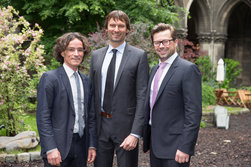Winners 2013
MAIN PRIZE
Federico Giudiceandrea from Italy has been the driving force behind the ground breaking new developments in electronic measurement and control systems for the woodworking industry. More than 30 years ago he had the idea to apply the image processing for industrial use and it was the initiator of the forthcoming developments in measuring and analysing the characteristics of wood. Over decades Giudiceandrea has been developing increasingly efficient methods, which are helping the woodworking industry to gain the maximum of quality and value from its raw-material. One of his most important achievements is the Multi-Sensor Scanner, which also set the seal on his company's (Microtec) success. The degree of automation, as it exists today at woodworking mills, has crucially been influenced by Giudiceandrea’s outstanding developments and his pioneering spirit!
Further information:
www.microtec.eu
INNOVATION PRIZES
Kielsteg-Element
Stefan Krestel and Ulrich Spiegel (both from Kielsteg GmbH, Austria) and Gernot Kulmer (Kulmer Holz-Leimbau, Austria) received the Innovation Prize 2013 for their novel Kielsteg lightweight construction element. Long-span roofs and intermediate floor structures are particularly suited to making full use of its exceptional characteristics. The element consists of top and bottom flanges produced of timber, whose task is to take the tensile and compressive forces in the bending situation. Plywood or oriented strand board (OSB) is used in a web to form the lightweight honeycomb structure in the Kielsteg element. The web structure brings enormous material savings and it can optimally capture the shear forces under load. Spans up to 27 metres are possible due to Kielsteg’s outstanding load-bearing capacity in relation to its own weight. The jury was not only impressed by the construction element itself, but also by the development of the special production technology, which allows also the production of cambered elements. The industrial production has to be efficient and simultaneously meet the requirement of the complex structure and assembly of the element. The numerous projects, which have been realised with Kielsteg elements, show the excellent potential of this innovative development.
Further information:
www.kielsteg.at
Glued-in perforated steel plates
_med.jpg)
from left to right: Friedemann Diehl, Rainer Bahmer, Leander Bathon, Jens Schmidt and Oliver Bletz-Mühldorfer
Leander Bathon and his team from RheinMain University of Applied Sciences, Germany, were rewarded for their development of a wood-steel composite system, which is based on glued-in perforated steel plates with high performance. This innovative connection technique has led to stunning solutions in wood construction, which until recently were considered impossible. Traditionally, large numbers of bolts, screws and other fasteners are required for coupling wood structural members. The holes drilled for fasteners weaken the cross-section of the wood, leading to a need for larger cross-sections, thereby increasing cost. The glued-in perforated steel plate connection method uses an entirely new approach: the wood is cut parallel to the grain, cavities of 4 mm are filled with adhesive and perforated steel plates are inserted to make the connection between structural members. The wooden structures are rigidly bonded but remain ductile; this provides new technical possibilities for wood construction, while also offering new solutions for their aesthetic appeal. This innovative connection technique is not only a theoretical concept; it has already been implemented in few spectacular building projects. The 100 metre high TimberTower for wind energy turbines (a Schweighofer Prize winner in 2009) and the floating staircase at the University of Vancouver, Canada, are examples. The jury regards this connection technique with glued-in perforated steel plates as an important and huge contribution to the development of modern wood construction.
Further information:
www.hs-rm.de/fab
www.hbv-systeme.de/hsk/system.htm
LifeCycle Tower - LCT ONE
Univ.-Prof. Architect Hermann Kaufmann (Austria) and Dipl.Ing. Hubert Rhomberg (CREE, Austria) received the innovation prize 2013 for the interdisciplinary development of an innovative wood construction system, which has already been realised in Dornbirn, Austria, in the form of the highly-regarded 8-storey LifeCycle Tower. The basic idea of this novel system is to combine the excellent technical and environmental characteristics of wood with the technical advantages specific to other building materials. The emphasis of this hybrid concept is on the reduced use of resources, meaning that wood is still the main building material but combined with other materials when their special properties are necessary to meet the technical challenges of the structural design. One example is the hybrid slab, in which wood is combined with reinforced concrete; thus the acoustic and fire safety requirements are met and the high compression strength of reinforced concrete comes in use. The hybrid slab is the key to constructing in ever higher buildings: in this way every storey is separated by a non-combustible layer in the structure. Another aim of the novel wood construction system was to have shorter construction times on site. This was accomplished admirably: it only took eight days to assemble the prefabricated façade elements and the hybrid slabs as the LifeCycle Tower was erected. The jury regards the system with hydrid slab as an important revolution in wood construction and a trend-setting development for wooden high-rise buildings.
Further information:
www.hermann-kaufmann.at
www.creebyrhomberg.com
Nordic Wooden Cities
Eva Britt Isager (City of Bergen), Norway and Hans Andrén (City of Växjö), Sweden, were rewarded for their outstanding achievement in establishing the Nordic Wooden Cities network. This is a cooperation of currently nine Nordic cities promoting modern urban development with wooden structures. The concept of the network is based on a “triple helix” environment, where different experts from municipalities, academia and the business sector actively work towards the same goals and constantly develop new ways of using more wood in buildings. The success of Nordic Wooden Cities is the open arena for dialogue and exchange of experiences and ideas; everything is shared between the countries, cities and partners in the network. The completed building projects are evaluated in all their aspects and the results are formulated into “Best practices” for all to use. The Nordic Wooden Cities inspire each other to create more innovative and expansive examples of building projects in their cities. And the network is growing – more cities, companies, institutions and universities are taking part. This winning project demonstrates that innovative ideas can be successfully implemented, provided they are planned in a holistic way and all relevant stakeholders are involved from the beginning.
Further information:
www.nordicwoodencities.com




_med.jpg)
_med.jpg)